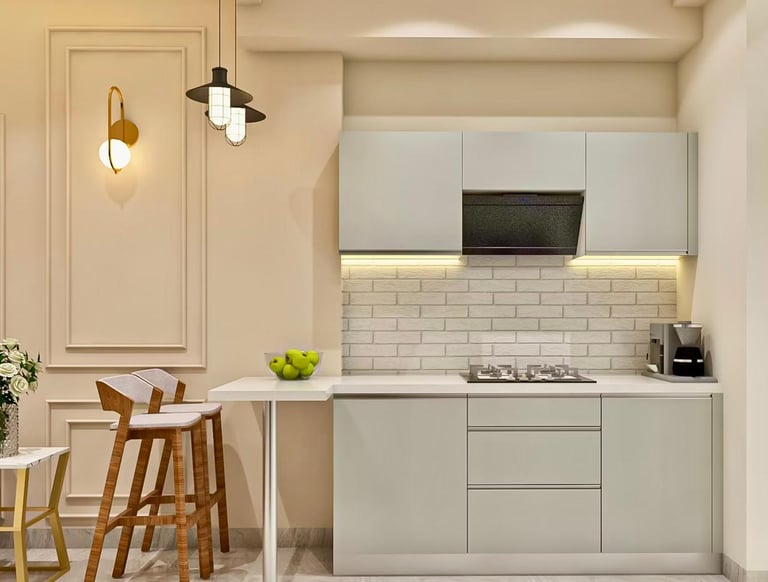SMALL HOME INTERIORS
Insights on what to consider while planning a small house's interior.
Sakina Baxa
6/6/20243 min read


Every Big City's Big Concern - SMALL HOMES!
As ironical as it sounds it is a fact that we have all embraced over time. But its not that bad if you may ask me, what with less maintenance??! But Designing a Small Home presents unique challenges and opportunities. To make the most of limited space, careful planning and thoughtful choices are essential. Here are key considerations to keep in mind when designing a small home:
1. Space Optimization
Maximizing the utility of every square foot is crucial in a small home. Multi-functional furniture, built-in storage, and clever design tricks can help make small spaces feel larger and more efficient.
Multi-Functional Furniture: Invest in pieces that serve more than one purpose, such as sofa beds, fold-out tables, and storage ottomans.
Built-In Storage: Utilize vertical space with built-in shelves and cabinets. Under-bed storage and wall-mounted racks can also help keep clutter at bay.
Open Floor Plans: Minimize walls to create a sense of openness. An open floor plan can make a small home feel more spacious and airy.
2. Natural Light
Ample natural light can make small spaces feel larger and more inviting. Consider the placement and size of windows to maximize light penetration.
Large Windows: Install large windows where possible to allow more light into the home.
Skylights and Light Tunnels: These can be excellent additions to bring light into otherwise dark areas.
Light Colors and Reflective Surfaces: Use light colors for walls and ceilings, and incorporate mirrors and glossy surfaces to reflect light throughout the space.
3. Functional Layout
A well-thought-out layout is essential to ensure each area of the home serves its purpose effectively.
Zoning: Create distinct zones for different activities, such as sleeping, eating, and working, without necessarily using walls to separate them.
Flow: Ensure there is a natural flow between different areas. Avoid placing furniture in a way that disrupts movement.
Compact and Efficient Kitchens: Design the kitchen to be compact but efficient, with smart storage solutions and appliances suited to the scale of the home.
4. Personalization and Comfort
Even a small home should reflect the personality and lifestyle of its inhabitants. Comfort should not be sacrificed for the sake of space-saving.
Personal Touches: Decorate with personal items that bring joy, such as photos, artwork, and keepsakes.
Comfortable Furnishings: Choose comfortable seating and bedding. Just because a space is small doesn’t mean it can’t be cozy.
Smart Technology: Incorporate smart home technology to increase convenience and efficiency, such as automated lighting and climate control systems.
Outdoor Spaces
If possible, extend living spaces to the outdoors to create a sense of additional space.
• Balconies and Patios: Even small balconies can be transformed into functional outdoor living areas.
• Garden Spaces: Use vertical gardening or container plants to add greenery without taking up much space.
• Outdoor Furniture: Choose space-saving outdoor furniture that can be folded or stacked when not in use.
6. Sustainability
Designing with sustainability in mind not only benefits the environment but can also lead to long-term cost savings.
Energy Efficiency: Opt for energy-efficient appliances and lighting. Consider solar panels if feasible.
Sustainable Materials: Use materials that are sustainably sourced and have a low environmental impact.
Water Conservation: Install low-flow fixtures and consider rainwater harvesting systems.
7. Future Flexibility
Design with future needs in mind to ensure the home can adapt to changing circumstances.
Flexible Spaces: Create spaces that can serve multiple purposes as needs change. For example, a home office can double as a guest room.
Expandable Options: Plan for potential expansions, such as adding an extra room or extending living areas outdoors.
Conclusion
Designing a small home requires a balance between functionality, comfort, and aesthetics. By focusing on space optimization, natural light, functional layouts, personalisation, outdoor spaces, sustainability, and future flexibility, you can create a small home that is both practical and inviting. Thoughtful design can transform even the smallest spaces into a comfortable and stylish haven.


